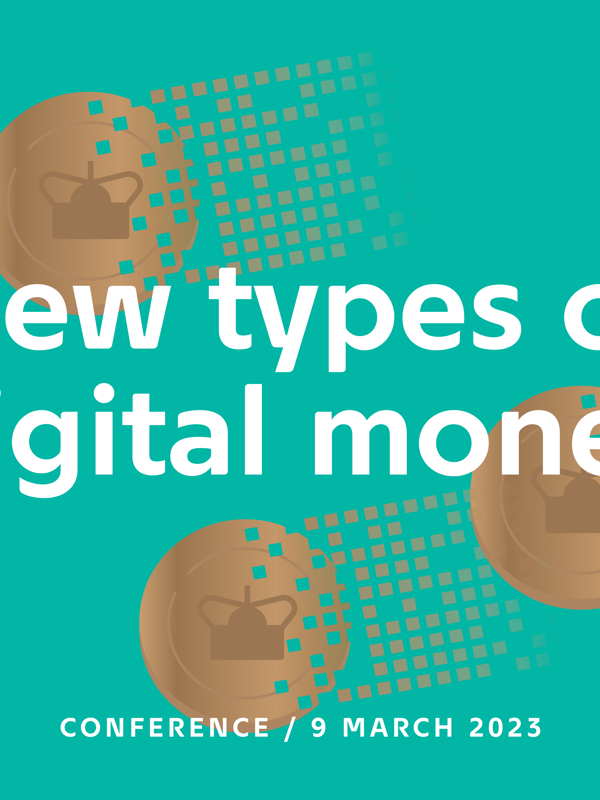New forms of digital money and new financial players have been gaining ground in recent years. The development is complex because it encompasses new types of assets, new financial service providers and various forms of regulation. The most talked-about new forms of money and assets are crypto-assets, stablecoins and central bank digital currency for citizens (retail CBDC).
Today, the most common forms of money are cash and bank deposits. Cash – banknotes and coins – is issued by Danmarks Nationalbank and is a receivable or a claim, as it is also called, against Danmarks Nationalbank.
Bank deposits on the other hand are digital money comprising household and corporate deposits with the banks. Bank deposits are issued by private banks and are thus a claim against the bank where the digital money is placed. For the same reason, the financial sector is regulated by the authorities, and the stability of the sector is overseen by, among others, Danmarks Nationalbank.
There are many different types of money. Recently, several more forms of digital money and assets have seen the light of day.

A common feature of the new assets and forms of money is that most are based on a technology called distributed ledger technology or blockchain. Crypto-assets and stablecoins both rely on this technology.
What is DLT and blockchain technology?
Distributed ledger technology (DLT) is a decentralised database technology where information is continuously registered and distributed between the participants in the network. With a decentralised database, there is no central part continually verifying, registering and storing information about ownership. All participants on the network can choose to store a copy of the database.
A blockchain is a variant of DLT, which, by means of cryptography, can ensure the integrity of data without a central part necessarily verifying the information.
What are crypto-assets?
A crypto-asset, such as bitcoin or ethereum, is a digital asset based on distributed ledger technology. The most well-known crypto-assets are so-called unbacked crypto-assets. This means that the value of the crypto-assets is not based on the value of one or more underlying – or backing – assets. Thus, the value of the crypto-assets is not based on tangible assets or specific liquidity or capital, which inevitably makes the crypto-assets highly risky and their price volatile.
Unbacked crypto-assets are associated with speculation, and due to their violent price fluctuations and uncertainty have not shown themselves to function well as money.
What are stablecoins?
In addition to the unbacked crypto-assets such as bitcoin and ethereum, there are also so-called backed or pegged crypto-assets. These are usually referred to as stablecoins. Backed crypto-assets, such as USD Coin and tether, follow or are based on the value of underlying assets. Here, the price of the crypto-asset follows the value of, e.g., currencies, commodities or other crypto-assets.
Most stablecoins are offered by a key player, such as a commercial business or a bank. The pegging takes place by placing the funds which are received through the sale of the stablecoins in the assets which the stablecoins in question are stated as being pegged to.
Whether stablecoins can function well as a means of payment depends in particular on trust and stability. Although the word ‘stable’ forms part of the term stablecoins, not all issuers of stablecoins are in practice able to ensure that the stablecoins in question follow the value of the attached asset.
The potential of stablecoins for supplementing the types of money we know today will, in particular, depend on how they are specifically regulated, whether the regulation is effective and whether their distribution benefits citizens and society.
Are stablecoins stable?
Not all issuers of stablecoins manage to maintain a stable value and thus ensure that buyers or investors can exchange their stablecoins for the assets to which the stablecoin in question is supposed to be pegged. In particular, for some types of algorithmic stablecoins, there have been examples where even minor value fluctuations have led to uncertainty among investors, with resulting sharp declines in the value.
One example of this is the algorithmic stablecoin Terra which, in May 2022, crashed from a value of just under 1 dollar to 0.1 dollars in a matter of days. Terra had a reserve consisting of the crypto-asset Luna. Luna has been issued by a fund that held a reserve primarily consisting of unbacked crypto-assets.
What is central bank digital currency?
In recent years, a number of central banks have examined the opportunities and challenges of issuing central bank digital currency (CBDC) to citizens and companies. Basically, a retail CBDC is a direct digital claim on a central bank for citizens and companies in the same way that cash is. In Denmark, a retail CBDC would, in practice, mean that Danmarks Nationalbank issued digital money to citizens and companies.
The reasons for the increased focus on CBDC differ from country to country. At present, and with the costs and potential risks associated with CBDC, it is not clear how a retail CBDC will create significant added value compared to the payment solutions that currently exist in Denmark.
Danmarks Nationalbank is closely following the developments in central bank digital currencies, in particular work carried out by the ECB in developing a Digital Euro. The bank participates actively in international working groups and forums that focus on new technology and on the opportunities, risks and costs associated with a retail CBDC.
Conference on new types of digital money
On 9 March, 2023, Danmarks Nationalbank hosted a conference on New types of digital money. The conference took stock on the current state of crypto assets and central bank digital currencies (CBDC) and shed light on what the future holds for new types of digital money.
